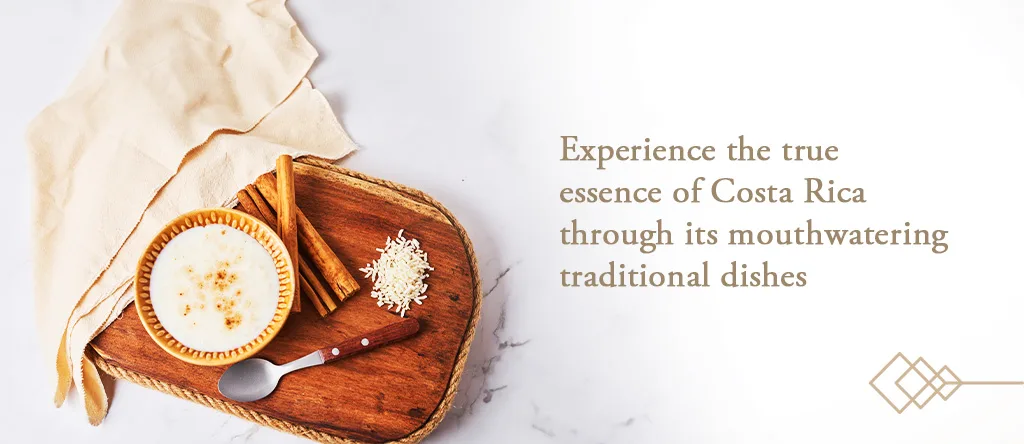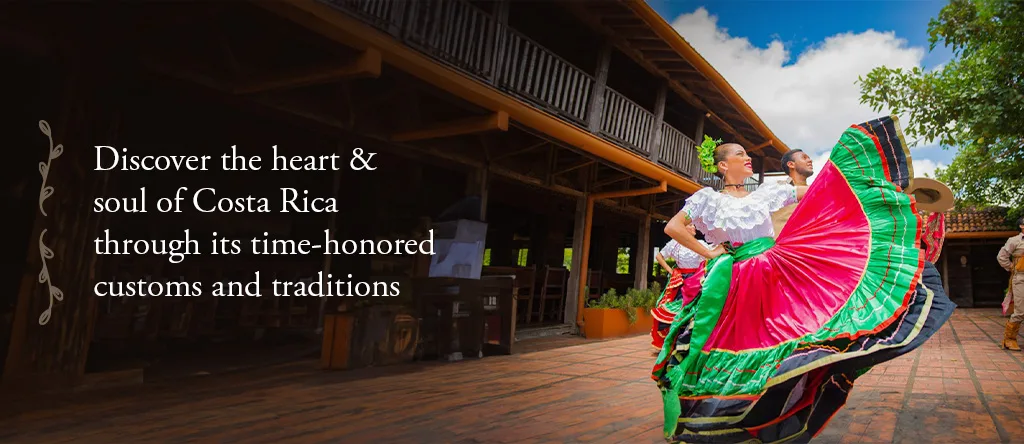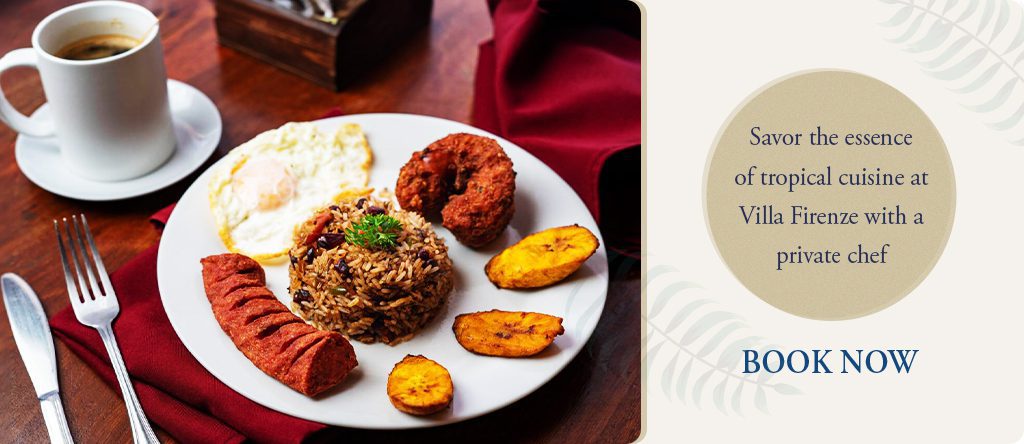Hey there, fellow food enthusiasts and wanderlust-driven adventurers! Today, we’re going on a mouthwatering journey to explore the vibrant and diverse world of Costa Rican cuisine. Costa Rica isn’t known just for its lush rainforests and pristine beaches; Costa Rica is a country that delights with its delicious and authentic gastronomy.
From bustling city streets to remote rural towns, you’ll find a delightful array of eateries, each offering its take on the nation’s treasured recipes. So, fasten your seatbelts, pack your appetite, and dive into the flavors that delight Costa Rican cuisine!
Costa Rican Culinary Heritage
Costa Rica’s culinary heritage is a captivating fusion of various cultural influences, reflecting the country’s diverse history and blending different ethnicities. Over the centuries, indigenous tribes, European colonizers, enslaved Africans, and immigrants from China, the Middle East, and other parts of the world have influenced Costa Rican Cuisine. These diverse cultural interactions have indelibly impacted the Costa Rican diet.

Indigenous Roots of Costa Rican Gastronomy
Long before the arrival of Spanish colonizers, indigenous tribes inhabited the land we now know as Costa Rica. Tribes, including the Bribri, Boruca, and Maleku, cultivated crops of maize, beans, squash, and yams. The techniques they used for cooking and food preservation, like grilling over an open flame and using natural herbs for seasoning, continue to influence Costa Rican cuisine today.
Many traditional dishes originated in indigenous practices, with ingredients like corn forming the basis for staples such as tortillas and tamale fillings. Even today, rural communities and the best luxury villas in Costa Rica proudly preserve their indigenous culinary traditions, allowing visitors to taste the flavors of Costa Rica’s past.
Colonial and European Influences on Traditional Costa Rican Dishes
With the arrival of Spanish conquistadors in the 16th century, Costa Rica became a part of the vast Spanish Empire. The colonizers introduced new ingredients and cooking techniques, leaving a lasting impression on the country’s culinary landscape.
One of the most significant contributions was the introduction of livestock, such as cattle, which led to a rise in beef-based dishes. Traditional meals like the “Olla de Carne,” a hearty beef stew with vegetables, exemplify the influence of Spanish cuisine.
Furthermore, the Spanish brought rice, onions, and garlic, which quickly integrated into the local Costa Rican food items. These ingredients became integral to dishes like “Arroz con Pollo” (rice with chicken), a famous comfort food across the country enjoy.
African and Afro-Caribbean Influences on the Country’s Cuisine
During the colonial era, Costa Rica, like many other Latin American countries, imported enslaved Africans to work on plantations. With their arrival, African influences began to shape the nation’s food culture, particularly in the Caribbean coastal regions. One of the most significant culinary gifts from the African heritage is rich and flavorful spices. Dishes like “Rice and Beans,” a Caribbean variation of Gallo Pinto, showcase the bold flavors achieved by combining rice, beans, and coconut milk, all seasoned to perfection.
Additionally, the Afro-Caribbean influence brought forth a love for seafood, resulting in delectable dishes such as “Pati” – a savory pastry filled with spicy meat or fish. Over time, this unique blend of African and Afro-Caribbean flavors has found its way into mainstream Costa Rican cuisine, adding a delightful twist to traditional dishes.
Staple Ingredients and Flavors of Authentic Costa Rican Cuisine
Costa Rican cooking is a delightful blend of fresh and vibrant ingredients, creating a tapestry of flavors that excite your taste buds. Let’s dive into the ingredients and flavors that form the heart and soul of this colorful cuisine!
- Rice and Beans: Imagine a plate with a mound of fluffy rice nestled beside a scoop of savory black beans – this is the beloved duo known as “Gallo Pinto.” This classic combination is the foundation of cuisine in Costa Rica and a fixture on breakfast, lunch, and dinner tables as traditional Costa Rican food.
- Plantains: Plantains are another star ingredient in famous Costa Rican food, adding flavor and texture to various dishes. When ripe, they turn a rich golden color and become sweet and soft, perfect for making “Plátanos Maduros.” These sweet fried plantains offer a delicious contrast to savory mains and are mouthwatering Costa Rican food.
- Lizano Sauce: When adding a flavor to Costa Rican dishes, Lizano sauce takes center stage. This iconic condiment is a tangy, slightly sweet sauce with a hint of spiciness, making it a perfect complement to rice and beans. Its unique blend of vegetables, spices, and even a touch of Worcestershire sauce creates a distinct Costa Rican taste.
- Seafood in Costa Rica: With coastlines on the Caribbean Sea and the Pacific Ocean, it’s no surprise that Costa Rica boasts abundant fresh seafood. One such delicacy is “Ceviche de Camarón,” a refreshing shrimp ceviche marinated in lime juice and mixed with onions, peppers, and cilantro. Another favorite is grilled fish topped with tropical fruit salsa, creating a symphony of flavors that dance on your palate.
- Tropical Fruits: Costa Rica’s tropical climate blesses the nation with luscious fruits, adding natural sweetness and vibrant colors to its cuisine. From the juicy sweetness of mangoes to the tangy zing of pineapples, tropical fruits are a part of various dishes, from salads to desserts. The sweetness of papaya, guava, and passion fruit often finds its way into refreshing fruit juices and smoothies, providing a delightful respite from the tropical heat.
Traditional Costa Rican Dishes
Costa Rican cuisine is a tapestry woven with a rich blend of flavors and traditions. Let’s dive into some of the most beloved and popular Costa Rican food that grace the tables of Costa Rican households and restaurants.
- Gallo Pinto: At the heart of every breakfast is “Gallo Pinto,” the quintessential Costa Rican dish. This delightful combination of rice, black beans, and aromatic spices creates a harmonious blend that dances on your taste buds. Often served with eggs, sour cream, and sweet plantains, Gallo Pinto is a dish that exemplifies the essence of Costa Rican culinary culture.
- Casado: Don’t be surprised if your breakfast seems more like a lunch spread! “Casado,” a hearty plate that translates to “married man,” is a complete meal. It features a generous portion of Gallo Pinto, complemented by rice, beans, a choice of meat (chicken, fish, or beef), salad, sweet plantains, and tortillas. This wholesome combination ensures you start your day with a happy stomach!
- Arroz con Pollo: While often served as a lunch or dinner dish, “Arroz con Pollo” also finds its way to the breakfast table on special occasions. This flavorful dish features succulent chicken pieces cooked with rice, vegetables and a savory blend of spices. The result is a delightful comfort food that warms the heart and the soul.
- Chorreadas: For those with a sweet tooth, “Chorreadas” offer a delectable treat. These mouthwatering corn pancakes are cooked fresh with corn kernels, milk, and sugar. Served with a dollop of sour cream or a sprinkling of cheese, Chorreadas is a delightful morning traditional Costa Rican food that will leave you craving more.
- Olla de Carne: While not a regular feature on the breakfast table, “Olla de Carne” is a traditional Costa Rican beef stew that graces many lunch and dinner gatherings. This hearty dish is simmered to perfection, featuring tender beef, an assortment of vegetables, yams, and plantains. Olla de Carne is a celebration of flavors that embodies the warmth and hospitality of Costa Rican cuisine.
Exploring the Flavorful World of Costa Rican Street Eats
From crispy turnovers to icy treats, the streets come alive with delightful and flavorful snacks. Let’s walk through the bustling streets and discover the irresistible street food delights that tantalize the taste buds of locals and visitors alike!
- Empanadas: Empanada is a favorite street food item, a delightful grab-and-go snack with mouthwatering fillings. These crispy turnovers are a load of gooey melted cheese, seasoned meat, or hearty black beans. Served hot and fresh from street food vendors, empanadas are perfect for satisfying hunger pangs while on the go.
- Tamales: Tamales are a beloved Costa Rican food delicacy wrapped in banana leaves. These handheld delights are a plate of cooked seasoned meat (such as chicken or pork) and a mix of vegetables, all nestled within a soft and flavorful corn masa. The banana leaves infuse the tamales with a distinct aroma and taste, accurately representing Costa Rican culinary heritage.
- Chifrijo: This flavorful dish features a combination of rice, beans, and crispy pork cracklings (chicharrones), topped with a zesty pico de gallo salsa. The delightful blend of textures and flavors makes Chifrijo a go-to choice for those looking to savor the taste of Costa Rica while enjoying a refreshing beverage. Churros: These fried dough pastries are sprinkled with a generous coating of cinnamon and sugar, making them a delectable snack to satisfy your sweet cravings. Best enjoyed warm and freshly made, Churros are the perfect pick-me-up for a delightful stroll through the streets.
- Granizados: When the tropical sun shines bright, nothing beats the cool and refreshing delight of “Granizados.” This icy treat is made by shaving ice and topping it with fruit syrups such as tamarind, mango, or passion fruit. As you take a spoonful of the fruity and chilly goodness, you’ll feel an instant refreshment, making Granizados a must-have on a hot Costa Rican Day.

Savoring the Delights of Costa Rican Desserts and Drinks
Costa Rican cuisine excels in savory dishes and boasts a delectable array of sweet treats and refreshing beverages. Let’s satisfy our sweet tooth and quench our thirst with the delightful world of Costa Rican desserts and drinks.
- Tres Leches Cake: This rich and moist sponge cake is a delight, but the magic lies in its soaking. The cake is generously drenched in three different kinds of milk – condensed, evaporated, and whole. This soaking infuses the cake with a luscious creaminess, leaving you craving more. Topped with a cloud of whipped cream, Tres Leches Cake is a must-try dessert that you can savor in almost every popular café in Costa Rica.
- Arroz con Leche: This heartwarming dessert combines tender rice, milk, cinnamon, and raisins, creating a creamy and aromatic treat. Often served warm, Arroz con Leche is the perfect way to end a meal or indulge in cozy bliss.
- Horchata: Quench your thirst with the excellent and refreshing “Horchata.” This delightful rice-based drink is infused with hints of cinnamon and vanilla, creating a harmonious blend of flavors. Horchata’s creamy and subtly sweet nature makes it a popular beverage choice, especially on warm days when you need a refreshing sip to cool down.
- Café Chorreado: Cafe Chorreado takes meticulous care; hot water pours over a cloth coffee filter suspended over a cup. This unique method allows the coffee to drip slowly, extracting its rich and robust flavors. The result is a smooth, aromatic, and utterly satisfying cup of coffee – a true delight for coffee lovers.
Embracing Traditions with Respect and Grace
When dining in Costa Rica, the experience goes beyond just the food. It is a celebration of culture, community, and cherished traditions. To fully appreciate the local customs and show respect to the warm-hearted Ticos, it’s essential to familiarize yourself with the customs and etiquettes of Costa Rica that governs their culinary experiences.
- Batidos: Made with various tropical fruits such as mango, pineapple, or watermelon, Batidos are blended to perfection with milk or water, creating a refreshing and nourishing treat. The fruits’ vibrant colors and natural sweetness make Batidos a delightful and healthy choice for a quick pick-me-up.
Insights into Costa Rican Dining Customs and Etiquette
Punctuality and Greetings: In Costa Rica, being on time is valued, whether dining at a restaurant or being invited to someone’s home. When arriving at a gathering, it is customary to greet each person with a handshake or a kiss on the cheek, depending on the level of familiarity.
Politeness and Gratitude: Ticos strongly emphasize courtesy and expressing gratitude. When dining at someone’s home or a restaurant, saying “buen provecho” to everyone at the table before starting the meal is customary. After the dining, expressing appreciation for the food and the company is considered courteous.
Use of Utensils: In formal settings, Costa Ricans follow standard Western dining etiquette, using cutlery appropriately. However, it is common to see people using their hands to eat certain foods, such as fried plantains or empanadas, especially in more relaxed settings.
Table Manners and Common Practices
- Passing of Dishes: When dining with others, it is customary for dishes to be placed at the center of the table for everyone to share. Instead of serving individual portions, food circles around, promoting a communal and convivial atmosphere.
- Eating Pace: Costa Ricans generally take their time when eating, savoring each bite and engaging in conversations between courses. This unhurried approach reflects the country’s “pura vida” lifestyle, where people enjoy life’s simple pleasures.
- Respecting Host’s Wishes: When dining at someone’s home, respecting the host’s wishes and trying every dish offered is essential. Declining food can be rude or unappreciative, as sharing meals shows hospitality and camaraderie.
- Leaving Little Food: It is polite to leave a small amount of food on your plate after eating. This gesture indicates that you savored a satisfying meal.
Sobremesa: Celebrating the Joy of Lingering Together
Sobremesa” is a cherished cultural practice in Costa Rica, emphasizing the value of quality time spent with family and friends around the dining table. After a meal, it is customary for people to linger at the table, engaging in lively conversations, sharing stories, and simply enjoying each other’s company.
This post-meal interaction often extends beyond the dining table and can last for hours. Sobremesa reflects the strong sense of community and connectedness in Costa Rican culture. It allows individuals to deepen their relationships, strengthen bonds, and create lasting memories.

Conclusion
We hope this Costa Rican food guide will come in handy for you during your vacation. Costa Rican cuisine is more than just a delightful array of flavors; it reflects the country’s cultural heritage and warm-hearted spirit. As you savor the rich dishes, explore the bustling streets, and embrace the customs of Costa Rican dining, you’ll find yourself indulging in delicious meals and connecting with the heart and soul of this enchanting nation.











